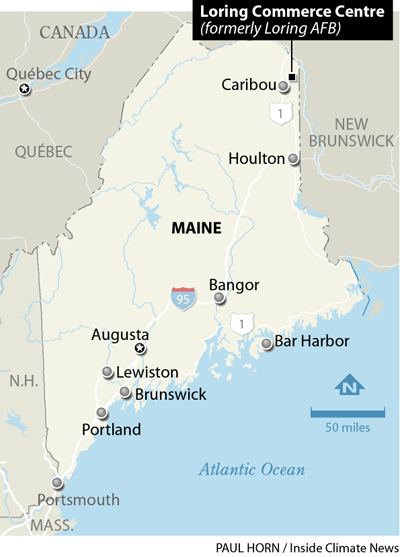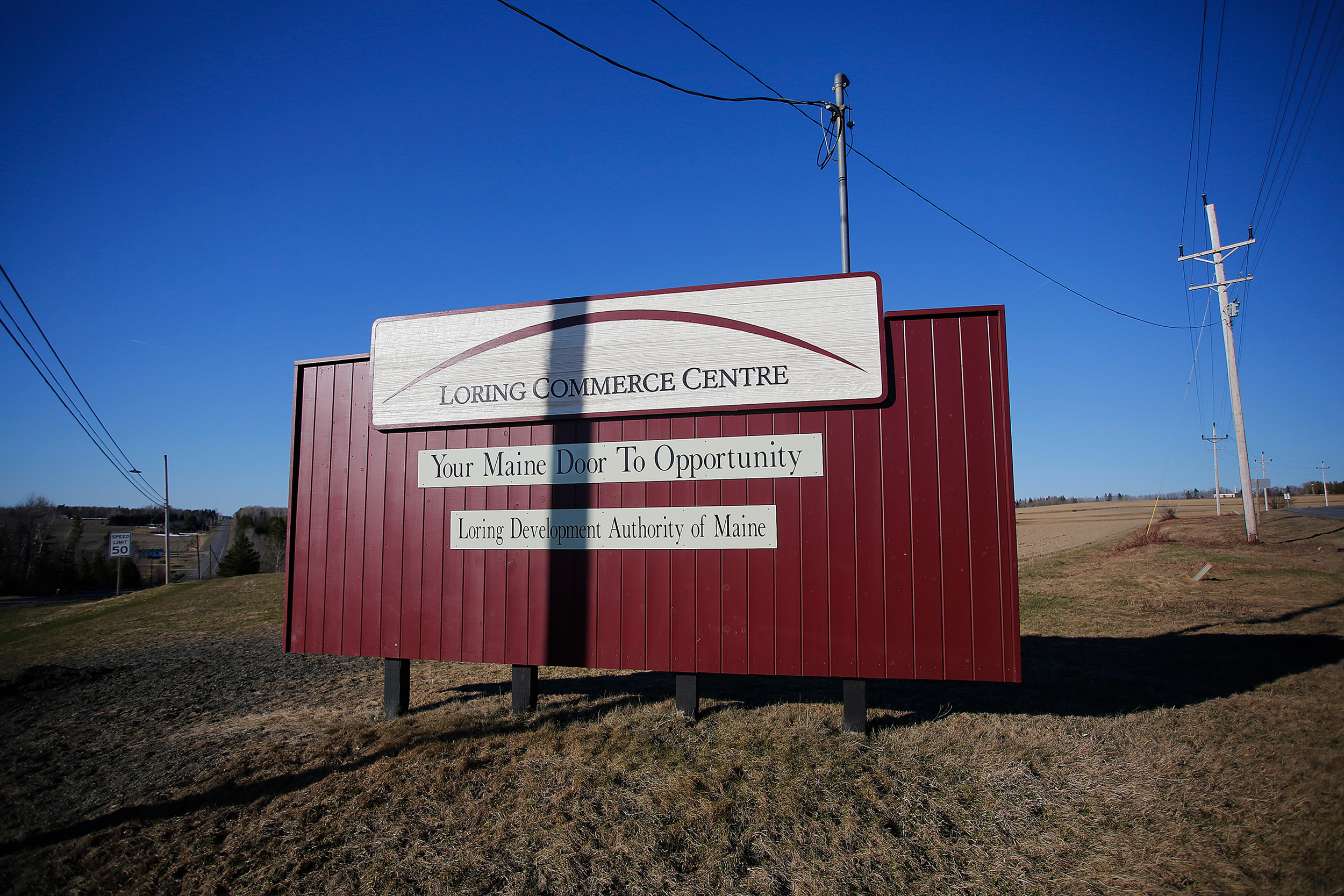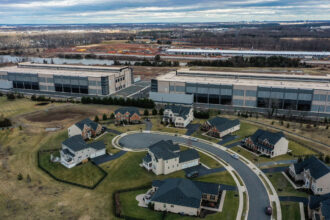Once a Cold War outpost near Maine’s northern border, the former Loring Air Force Base could soon be home to a very different kind of facility: the state’s first large-scale data center. The sprawling 450-acre site in Limestone, Maine, would host the giant server farm as part of a plan still in its early stages to reinvent part of the base as a hub for green technology.
Since its closure in the early 1990s, the Loring Development Authority has redeveloped the base into a business park and a commercial airport. More recently, it has also become a sustainability-focused campus through the company Green 4 Maine.
Developers say Loring’s fiber network and access to renewable hydropower make it an ideal site for a next-generation data center powered entirely by green energy and using water-free cooling technology. But questions remain over how such an energy-intensive project could impact utility rates, grid reliability and a sensitive surrounding environment.
Traditionally, data centers, among the most power-hungry and resource-dependent buildings in the world, rely on massive cooling systems to keep thousands of servers from overheating. Some use energy-intensive fans that circulate air through vast server halls, while others depend on large volumes of water to absorb heat. “I wake up every morning wondering why we still use air to try and cool electronics,” said Herb Zien, vice chair of LiquidCool Solutions, one of the developers of LiquidCool Data Center. “As a thermodynamics engineer, I used to use air to insulate, not cool.”
LiquidCool Solutions, a privately held company based in Rochester, Minnesota, takes a different approach to cooling electronic technology. Its “immersion cooling” technology, Zien said, submerges computer components in a nonconductive, oil-based fluid that draws heat directly from the source—eliminating the need for fans, air conditioning or water. The system produces no toxic byproducts or emissions and, according to the company, nearly eliminates both noise and evaporative loss.
Loring, company officials say, will serve as the first large-scale data center built entirely around its technology—its first real-world test. “We believe this technology is the endgame for cooling electronics,” said Zien.
While the data center’s cooling technology may offer a “blueprint for the future of green technology,” the project’s broader grid and environmental impacts remain uncertain.
The developers say they plan to start with a 2- to 6-megawatt data center, with the capacity to scale up to 50 megawatts and potentially more if demand grows, according to Zien, and that it will be entirely powered by renewable energy—mainly hydroelectricity.
Versant Power, the region’s transmission and delivery utility, wrote in an email that while 50 megawatts of capacity is available, it could not verify that the supply would come from hydro or renewable sources. The utility added that grid upgrades would likely be necessary to support the project—costs that would be covered by the developers.
A Harvard Law School Environmental and Energy Law Program study found that, while initial costs are paid for by the developers, data center projects often shift expenses onto ratepayers through discounted or tailored negotiated contracts, wholesale market charges and grid upgrades that may exceed what’s necessary for reliability.

“Adding 50 megawatts to such a small, isolated grid is huge,” said Hepeng Li, an assistant professor at the University of Maine’s College of Engineering and Computing. Northern Maine’s independent grid has a peak load of roughly 150 megawatts, meaning the data center alone could consume more than a third of the region’s total demand.
Nearly 50 megawatts of mostly hydroelectric power—currently supplied by New Brunswick Power—is available at a nearby substation, according to Zien. New Brunswick Power told Inside Climate News that no supply agreement or memorandum of understanding is in place with either Green 4 Maine or the Loring Data Center project.
“It’s really just too early to tell what the impact of this data center will be,” said Philip L. Bartlett II, Maine Public Utilities Commission Chairman. “Part of the challenge with data center development we’ve seen throughout the country is we see a lot of PR statements before real commitments and contracts.”
Developers also plan to install on-site diesel generators to provide backup power during grid outages. While standard for data centers, a diesel backup system can emit harmful air pollutants—including particulate matter, volatile organic compounds and nitrogen oxides—posing potential risks to the Mi’kmaq Nation and the Aroostook National Wildlife Refuge, which border the site.
“If generators are only running 20 to 40 hours a year, the impacts should be pretty minimal,” said Shoali Ren, a data center researcher at the University of California, Riverside. Public health concerns, Ren noted, typically arise when diesel generators are clustered in one area or when an unreliable grid forces them to operate more frequently.
Project officials say generators would not be installed immediately and that some future users might choose to operate without them.
But at Loring, how the generators will ultimately be operated—and how often they might run—remains unclear, leaving key questions about potential air-quality impacts unanswered. Those uncertainties would only grow if the project succeeds and the developers expand the data center beyond its initial 2- to 6-megawatt capacity. Even so, supporters and researchers say that if the cooling technology performs as promised and the developers can secure a reliable supply of Canadian hydropower, the project has the potential to chart a new direction for cleaner, water-free data center development—and bring economic value to a region that has struggled since Loring’s closure.
About This Story
Perhaps you noticed: This story, like all the news we publish, is free to read. That’s because Inside Climate News is a 501c3 nonprofit organization. We do not charge a subscription fee, lock our news behind a paywall, or clutter our website with ads. We make our news on climate and the environment freely available to you and anyone who wants it.
That’s not all. We also share our news for free with scores of other media organizations around the country. Many of them can’t afford to do environmental journalism of their own. We’ve built bureaus from coast to coast to report local stories, collaborate with local newsrooms and co-publish articles so that this vital work is shared as widely as possible.
Two of us launched ICN in 2007. Six years later we earned a Pulitzer Prize for National Reporting, and now we run the oldest and largest dedicated climate newsroom in the nation. We tell the story in all its complexity. We hold polluters accountable. We expose environmental injustice. We debunk misinformation. We scrutinize solutions and inspire action.
Donations from readers like you fund every aspect of what we do. If you don’t already, will you support our ongoing work, our reporting on the biggest crisis facing our planet, and help us reach even more readers in more places?
Please take a moment to make a tax-deductible donation. Every one of them makes a difference.
Thank you,














